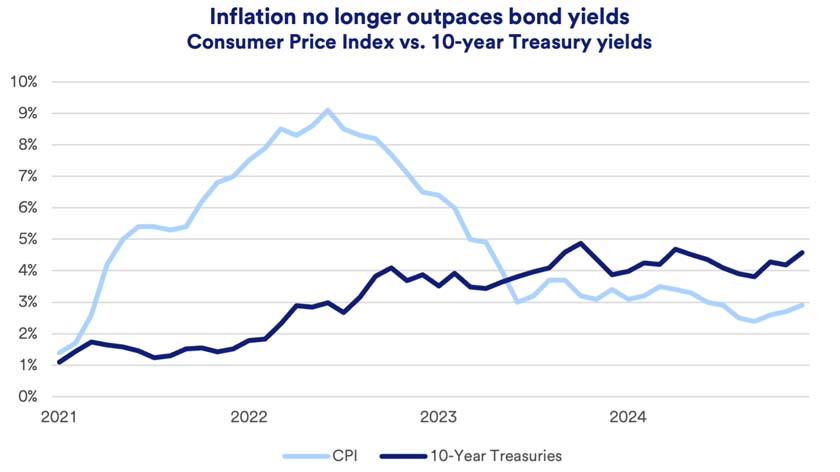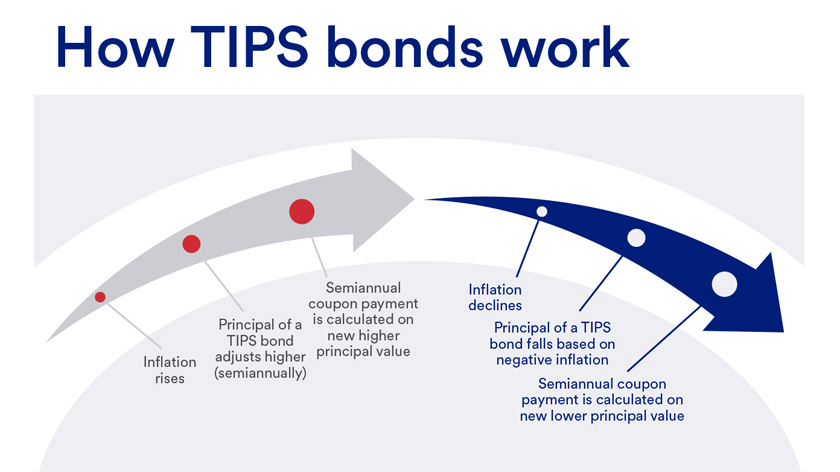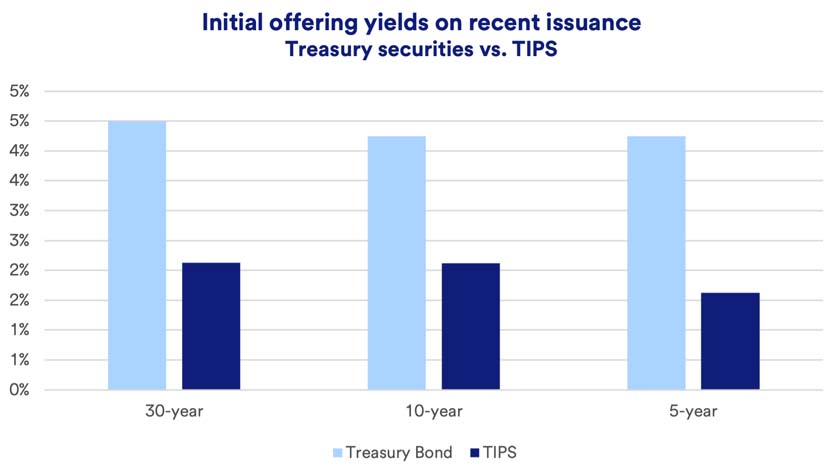In terms of the interest rate’s impact, Haworth notes that just as with other Treasury securities, TIPS are at a disadvantage when rates rise, or during periods of modest inflation.
“When interest rates are rising, prices of TIPS are subject to a loss in value just as is the case with other types of bonds,” he says. “The impact of inflation is still reflected in the price of TIPS, but they’re also subject to changes in the broader interest rate environment.”
As of early 2025, Haworth notes TIPS are generally competitive with Treasury securities. However, Haworth says investors may wish to consider other, non-government bond opportunities. “Another option to boost income is to look at more complex credits rather than investing in TIPS to protect against an inflation surprise,” says Haworth. “With vehicles like certain residential mortgage-backed securities, commercial mortgage-backed securities and collateralized loan obligations, you’ll earn more competitive income from the start.” Note that unlike TIPS, these complex credits are not backed by the full faith and credit of the U.S. government.
Opportunities and risks with TIPS
As you think about how TIPS might fit into your portfolio, it can be helpful to weigh the opportunities they provide along with the risks.
Opportunities:
- TIPS allow bond investors to achieve a degree of inflation protection not available in most other fixed-income investments.
- TIPS are backed by the full faith and credit of the U.S. government, meaning they have low credit risk.
- Both underlying principal and the income it generates can rise in line with the rate of inflation.
- At maturity, the principal value of TIPS will be no lower than your initial investment.
Risks:
- As with traditional bonds, the underlying value of TIPS can decline in times when interest rates are rising.
- In deflationary times, the value of TIPS and income generated from them will decline.
- Any appreciation in principal value is taxable even before you realize those gains.
These are also good talking points when meeting with a financial professional.
TIPS bonds FAQ
Here are some frequently asked questions about TIPS that you should consider before investing in them.
How do I buy TIPS bonds?
TIPS are issued at various times throughout the year and are sold in $100 increments. You can purchase TIPS through the U.S. Treasury website with maturities at auction of 5, 10 or 30 years. You can also purchase bonds with interim maturities through a bank or brokerage firm, or directly online. Certain mutual funds and exchange traded funds (ETFs) may also invest in TIPS, an approach that can provide tax advantages (see “Are TIPS bonds taxed?” below).
When is a good time to buy TIPS bonds?
“TIPS tend to perform best in periods when the interest rate environment is relatively stable but inflation is suddenly moving higher,” says Haworth. “In periods like these, the inflation adjustments in TIPS can provide some advantages.”
What is the outlook for TIPS?
After a period of elevated prices, inflation recently dropped below 3%, closer to its long-term average. “In this environment, TIPS’ potential benefits are less evident,” says Haworth. He notes that given the recent yield environment, TIPS may look competitive with traditional government bonds.
Haworth says in today’s environment, investors seeking yield advantages may also consider non- government agency issued residential mortgage-backed securities, collateralized mortgage obligations (CMOs) or, where appropriate, reinsurance pools.
How often do TIPS pay interest?
TIPS pay interest every six months until the bond’s maturity. The rate of interest is fixed and based on the underlying principal value. Since the principal value can change, the interest amount can change as well. This is unlike a conventional Treasury bond, which pay a constant income stream regardless of market or inflationary conditions.
Are TIPS bonds taxed?
Tax treatment of TIPS is a significant consideration. Interest payments from TIPS are subject to federal tax but are exempt from state and local taxes. In addition, if the principal value increases, the amount of that increase is taxable at the federal level in the year it occurs. “It’s best to own TIPS through a mutual fund or exchange traded fund (ETF),” says Haworth. “If you purchase TIPS directly, you’ll owe taxes on the imputed interest inflation adjustment.” This is an effect referred to as “phantom income.”
When do I receive the TIPS bond principle?
The inflation-adjusted principal value isn’t realized until the bond issue matures or you sell it. At that point, you would receive the adjusted principal value or the original principal value, whichever is higher.
Can I lose money on a TIPS bond?
You will never receive less from a TIPS bond than the original amount you paid for it.
How is inflation measured for TIPS bonds?
TIPS Inflation Index Ratios2 are provided by the U.S. Treasury Department to help calculate the impact on bonds.
Do TIPS always provide inflation protection?
Since TIPS typically pay an interest rate that is lower than that offered by a comparable Treasury security, investors may not benefit from inflation protection if cost-of-living changes are minimal over the holding period.
Seek professional advice before investing in TIPS bonds
Before buying TIPS bonds, you should assess current inflation expectations or consider the degree of inflation protection you need in your fixed-income portfolio. A financial professional can help you determine if TIPS are a good fit for your investment portfolio.
Learn how we approach investment management.





